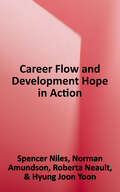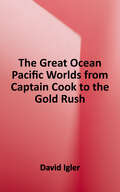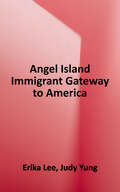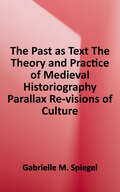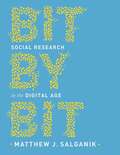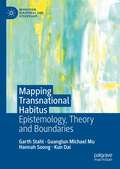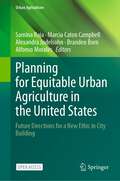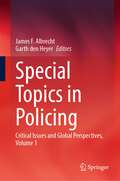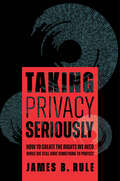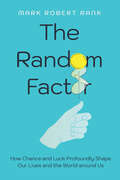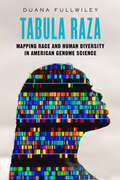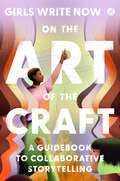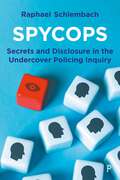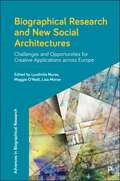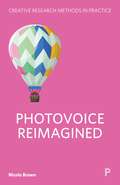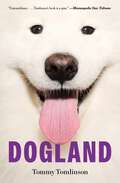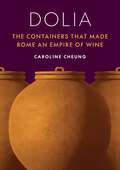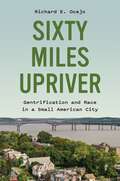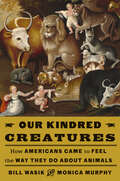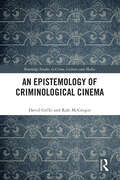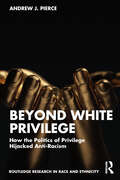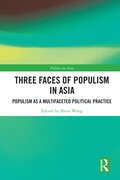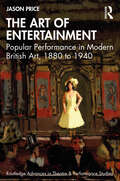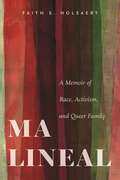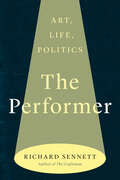- Table View
- List View
Career Flow and Development: Hope in Action, Second Edition
by Roberta Neault Spencer Niles Hyung Joon Yoon Norman AmundsonThis book introduces students to the Hope-Action Theory. This model emphasizes the centrality of hope in identifying positive career possibilities grounded in self-clarity emerging from systematic self-reflection. The book highlights how students can apply self-clarity to create a personalized vision of a future professional or educational career. Based on leading theories of human behavior and organizational management, the Hope-Action Theory provides students with a dynamic set of tools that support and encourage effective decision-making. Readers learn how to leverage hope, self-reflection, self-clarity, visioning, goal-setting, as well as planning, implementation, and adaptation strategies, to guide their careers. The book challenges students to develop specific goals and plans, set those plans in motion, then utilize new experiences to inform their ongoing decision-making. The text provides stories, examples, case vignettes, activities, and assessments to reinforce the material. The Hope-Action Inventory helps student assess areas of opportunity and personal growth. Career Flow and Development is an ideal resource for courses in career planning. It can also be used by career advisors working with students or within counseling programs to show future practitioners how to conduct career interventions.
The Great Ocean: Pacific Worlds from Captain Cook to the Gold Rush
by David IglerThe Pacific of the early eighteenth century was not a single ocean but a vast and varied waterscape, a place of baffling complexity, with 25,000 islands and seemingly endless continental shorelines. But with the voyages of Captain James Cook, global attention turned to the Pacific, and European and American dreams of scientific exploration, trade, and empire grew dramatically. By the time of the California gold rush, the Pacific's many shores were fully integrated into world markets and world consciousness. The Great Ocean draws on hundreds of documented voyages--some painstakingly recorded by participants, some only known by archeological remains or indigenous memory--as a window into the commercial, cultural, and ecological upheavals following Cook's exploits, focusing in particular on the eastern Pacific in the decades between the 1770s and the 1840s. Beginning with the expansion of trade as seen via the travels of William Shaler, captain of the American Brig Lelia Byrd, historian David Igler uncovers a world where voyagers, traders, hunters, and native peoples met one another in episodes often marked by violence and tragedy. Igler describes how indigenous communities struggled against introduced diseases that cut through the heart of their communities; how the ordeal of Russian Timofei Tarakanov typified the common practice of taking hostages and prisoners; how Mary Brewster witnessed first-hand the bloody "great hunt" that decimated otters, seals, and whales; how Adelbert von Chamisso scoured the region, carefully compiling his notes on natural history; and how James Dwight Dana rivaled Charles Darwin in his pursuit of knowledge on a global scale. These stories--and the historical themes that tie them together--offer a fresh perspective on the oceanic worlds of the eastern Pacific. Ambitious and broadly conceived, The Great Ocean is the first book to weave together American, oceanic, and world history in a path-breaking portrait of the Pacific world.
Angel Island: Immigrant Gateway to America
by Judy Yung Erika LeeFrom 1910 to 1940, over half a million people sailed through the Golden Gate, hoping to start a new life in America. But they did not all disembark in San Francisco; instead, most were ferried across the bay to the Angel Island Immigration Station. For many, this was the real gateway to the United States. For others, it was a prison and their final destination, before being sent home. In this landmark book, historians Erika Lee and Judy Yung (both descendants of immigrants detained on the island) provide the first comprehensive history of the Angel Island Immigration Station. Drawing on extensive new research, including immigration records, oral histories, and inscriptions on the barrack walls, the authors produce a sweeping yet intensely personal history of Chinese "paper sons," Japanese picture brides, Korean students, South Asian political activists, Russian and Jewish refugees, Mexican families, Filipino repatriates, and many others from around the world. Their experiences on Angel Island reveal how America's discriminatory immigration policies changed the lives of immigrants and transformed the nation. A place of heartrending history and breathtaking beauty, the Angel Island Immigration Station is a National Historic Landmark, and like Ellis Island, it is recognized as one of the most important sites where America's immigration history was made. This fascinating history is ultimately about America itself and its complicated relationship to immigration, a story that continues today. Winner of the Asian/Pacific American Librarians Association Award for Adult Non-Fiction Winner of the Western History Association Caughey Prize.
The Past as Text: The Theory and Practice of Medieval Historiography
by Gabrielle M. SpiegelThis study of familiar medieval histories and chronicles argues that the historian should be aware of the discursive nature, literary modes, and ideological investments of such texts as well as the social circumstances to which they were applied and by which they were generated. Postmodernism has challenged historians to look at historical texts in a new way and to be skeptical of the claim that one can confidently retrieve "fact" from historical writings. In The Past as Text historian Gabrielle M. Spiegel sets out to read medieval histories and chronicles in light of the critical-theoretical problems raised by postmodernism. At the same time, she urges a method of analysis that enables the reader to recognize these texts simultaneously as artifice and as works deeply embedded in a historically determinate, knowable social world. Beginning with a theoretical basis for the study of medieval historiography, Spiegel demonstrates her theory in practice, offering readings of medieval histories and chronicles as literary, social, and political constructions. The study insightfully concludes that historians should be equally aware of the discursive nature, literary modes, and ideological investments of such texts and the social circumstances to which they were applied and by which they were generated. Arguing for the "social logic of the text," Spiegel provides historians with a way to retrieve the social significance and conceptual claims produced by these medieval or any historical writings.
Bit by Bit: Social Research in the Digital Age
by Matthew J. SalganikAn innovative and accessible guide to doing social research in the digital age <p><p> In just the past several years, we have witnessed the birth and rapid spread of social media, mobile phones, and numerous other digital marvels. In addition to changing how we live, these tools enable us to collect and process data about human behavior on a scale never before imaginable, offering entirely new approaches to core questions about social behavior. Bit by Bit is the key to unlocking these powerful methods―a landmark book that will fundamentally change how the next generation of social scientists and data scientists explores the world around us. <p><p> Bit by Bit is the essential guide to mastering the key principles of doing social research in this fast-evolving digital age. In this comprehensive yet accessible book, Matthew Salganik explains how the digital revolution is transforming how social scientists observe behavior, ask questions, run experiments, and engage in mass collaborations. He provides a wealth of real-world examples throughout and also lays out a principles-based approach to handling ethical challenges.
Mapping Transnational Habitus: Epistemology, Theory and Boundaries (Migration, Diasporas and Citizenship)
by Guanglun Michael Mu Garth Stahl Hannah Soong Kun DaiThis book surveys and critiques existing empirical and theoretical literature on the Bourdieu-informed concept of transnational habitus. The term "transnational” has been used widely in studies of migration research where it has allowed scholars to have a deeper understanding of the practices not only of migrants moving across national borders but also of agents taking positions in transnational spaces without necessarily criss-crossing different nation states. Focusing on the potential of transnational habitus as an analytical tool, the authors propose a model of transnational habitus to identify integral key factors for the operationalisation in research. Drawing on reflexivity, the authors analyse transnational selves and map transnational spaces of classification. Identifying strengths, inconsistencies and key problems in this rapidly developing body of literature, this interdisciplinary and international book will be of interest to students and scholars in sociology, anthropology, migration studies, cultural studies, human geography, as well as diaspora studies.
Planning for Equitable Urban Agriculture in the United States: Future Directions for a New Ethic in City Building (Urban Agriculture)
by Alfonso Morales Samina Raja Marcia Caton Campbell Alexandra Judelsohn Branden BornThis open access book, building on the legacy of food systems scholar and advocate, Jerome Kaufman, examines the potential and pitfalls of planning for urban agriculture (UA) in the United States, especially in how questions of ethics and equity are addressed. The book is organized into six sections. Written by a team of scholars and practitioners, the book covers a comprehensive array of topics ranging from theory to practice of planning for equitable urban agriculture. Section 1 makes the case for re-imagining agriculture as central to urban landscapes, and unpacks why, how, and when planning should support UA, and more broadly food systems. Section 2, written by early career and seasoned scholars, provides a theoretical foundation for the book. Section 3, written by teams of scholars and community partners, examines how civic agriculture is unfolding across urban landscapes, led largely by community organizations. Section 4, written by planning practitionersand scholars, documents local government planning tied to urban agriculture, focusing especially on how they address questions of equity. Section 5 explores UA as a locus of pedagogy of equity. Section 6 places the UA movement in the US within a global context, and concludes with ideas and challenges for the future. The book concludes with a call for planning as public nurturance – an approach that can be illustrated through urban agriculture. Planning as public nurturance is a value-explicit process that centers an ethics of care, especially protecting the interests of publics that are marginalized. It builds the capacity of marginalized groups to authentically co-design and participate in planning/policy processes. Such a planning approach requires that progress toward equitable outcomes is consistently evaluated through accountability measures. And, finally, such an approach requires attention to structural and institutional inequities. Addressing these four elements is more likelyto create a condition under which urban agriculture may be used as a lever in the planning and development of more just and equitable cities. This is an open access book.This is an open access book.
Special Topics in Policing: Critical Issues and Global Perspectives, Volume 1
by James F. Albrecht Garth Den HeyerThis book comprehensively examines five key areas of concern across the field of policing. These critical issues include: police use of force, police ethics and integrity, traffic safety, police-community collaboration, and optimizing organizational performance and service delivery. The chapters that follow provide a global, multi-faceted approach to analyze these core professional issues, examine them through sociological and theoretical lenses, and ultimately propose policy recommendations to ensure optimal professionalism and organizational effectiveness. The book focuses on issues, including:• Enhancing public trust and confidence• Effective crime control• Rule of law• Social justice• Best procedures and practices This book is ideal for upper-level undergraduate and graduate-level students, criminal justice and law enforcement practitioners and policy makers, and criminal justice and criminology researchers.
Taking Privacy Seriously: How to Create the Rights We Need While We Still Have Something to Protect
by James B. RuleOther books remind us of what we already know—that privacy is under great pressure. James Rule provides a step-by-step plan to create a significantly more private and authentically democratic world. Taking Privacy Seriously offers both a concise, hard-hitting assessment of the origins of today’s privacy-eroding practices and a roadmap for creating robust new individual rights over our personal data. Rule proposes eleven key reforms in the control and use of personal information, all aimed at redressing the balance of power between ordinary citizens and data-hungry corporate and government institutions. What a privacy-deprived America needs most is not less technology, Rule argues, but profound political realignment. His eleven proposed reforms range from launching a major public-works investment consisting of a series of websites publicly documenting the personal data uses of nearly all government and private institutions; to instating a right for any citizen to withdraw from any personal data system not required by law; to creating a universal property right over commercial exploitation of data on oneself—so that no company or other organization could profit from use or sale of such data without permission. Succinct and compelling, Taking Privacy Seriously explains how we can refashion information technologies so that they serve human needs, not the other way around.
The Random Factor: How Chance and Luck Profoundly Shape Our Lives and the World around Us
by Prof. Mark Robert RankUpending notions of predictability and rugged individualism to reveal how truly random the world is. It’s comforting to think that we can be successful because we work hard, climb ladders, and get what we deserve, but each of us has been profoundly touched by randomness. Chance is shown to play a crucial role in shaping outcomes across history, throughout the natural world, and in our everyday lives. In The Random Factor, Mark Robert Rank draws from a wealth of evidence, including interviews and research, to explain how luck and chance play out and reveals how we can use these lessons to guide our personal lives and public policies. The Random Factor traverses luck from macro to micro, from events like the Cuban Missile Crisis to our personal encounters and relationships. From his perspective as a scholar of poverty, Rank also delves into the class and race dynamics of chance, emphasizing the stark disparities it brings to light. This transformative book prompts a new understanding of the twists and turns in our daily lives and encourages readers to fully appreciate the surprising world of randomness in which we live.
Tabula Raza: Mapping Race and Human Diversity in American Genome Science (Atelier: Ethnographic Inquiry in the Twenty-First Century #14)
by Duana FullwileyDuana Fullwiley has penned an intimate chronicle of laboratory life in the genomic age. She presents many of the influential scientists at the forefront of genetics who have redefined how we practice medicine and law and understand ancestry in an era of big data and waning privacy. Exceedingly relatable and human, the scientists in these pages often struggle for visibility, teeter on the tightrope of inclusion, and work tirelessly to imprint the future. As they actively imagine a more equal and just world, they often find themselves ensnared in reproducing timeworn conceits of race and racism that can seed the same health disparities they hope to resolve. Nothing dynamic can live for long as a blank slate, an innocent tabula rasa. But how the blank slate of the once-raceless human genome became one of racial differences, in various forms of what Fullwiley calls the tabula raza, has a very specific and familiar history—one that has cycled through the ages in unexpected ways.
On the Art of the Craft: A Guidebook to Collaborative Storytelling
by Girls Write NowA writing companion, inspirational guide to the craft, and anthology featuring interactive multi-genre work from the acclaimed organization on its twenty-fifth anniversary.We all have stories to tell, but not everyone gets the mentoring and training or encouragement to become a great storyteller. Founded a quarter century ago, Girls Write Now has empowered young women and gender-expansive youth to harness their creative talents, gaining confidence, skills, and a community supporting them in sharing stories the world needs to hear.This hands-on guide—conceived of and written and edited by the young people of Girls Write Now—draws from the organization’s dynamic curriculum and the writers’ own personal experiences spanning decades. It offers aspiring writers the tools they need to develop their craft—including tips, insight, and advice on the writing and publishing process as well as critical thinking about the future of storytelling.With this handbook, readers everywhere can equip themselves to shape their life stories, and become the writers and leaders they dream of being.
Spycops: Secrets and Disclosure in the Undercover Policing Inquiry
by Raphael SchlembachThe ‘spycops’ scandal has laid bare the existence of secretive police units that sent undercover police officers to infiltrate and undermine hundreds of political campaigns and activist groups. This is the first academic analysis of the activists’ experiences and their attempts to find answers and accountability in the Undercover Policing Inquiry. Written from the perspective of the ‘policed’, the author draws on extensive fieldwork and his first-hand experience of police infiltration through his participation in climate campaigns.
Biographical Research and New Social Architectures: Challenges and Opportunities for Creative Applications across Europe (Advances in Biographical Research)
by Tamsin Barber Diana Yeh Magda Nico Ana Caetano Kateřina Sidiropulu-Janků Ciara Bradley Andre Epp Jakub Gałęziowski Sónia Bernardo Correia Anabela Pereira Lynsey Kavanagh Jerzy Stachowiak Fabienne Seifert Oksana ŽabkoThis volume focuses on the place of biographical research in shaping social futures and its creative applications in the new unprecedented societal circumstances caused by the COVID-19 pandemic. Written by experienced and early career biographical researchers, it demonstrates how biographical research responds to the new ‘social architecture’: theoretically, empirically and analytically.
Photovoice Reimagined (Creative Research Methods in Practice)
by Nicole BrownOver the past decades, ‘photovoice’ has emerged as a participatory and creative research method in which participants capture and discuss their reality through photographs. This indispensable ‘how-to’ book with exercises and visual aids takes novice and veteran researchers through the practicalities and ethics of applying this approach. Written by experienced teacher Nicole Brown, the book: - outlines the conceptual foundations and historical development of the approach; - redefines photovoice as a research method and as a framework; - explores how photovoice can be used in all stages of research from data collection to dissemination; - provides guidance and food for thought to get researchers started on their project. Each chapter ends with exercises that focus readers' learning and understanding by practically engaging them in the work presented throughout. The examples and visual aids will help them recognise all the details presented and represented in a photograph. For researchers who would like to try their hand at photovoice as a method or as a framework to foster a more participatory approach, this is the ultimate guide to kickstart their project.
Dogland: Passion, Glory, and Lots of Slobber at the Westminster Dog Show
by Tommy Tomlinson&“Extraordinary...Tomlinson&’s book is a gem.&” —Minneapolis Star Tribune * &“Delightful.&” —Town & Country * &“This book wants to lick your face. Let it.&” —Kirkus Reviews From Pulitzer Prize finalist Tommy Tomlinson comes an inside account of the Westminster Dog Show that follows one dog on his quest to become a champion—and explores the bond between dogs and their people.Tommy Tomlinson was watching a dog show on television a few years ago when he had a sudden thought: Are those dogs happy? How about pet dogs—are they happy? Those questions sparked a quest to venture inside the dog-show world, in search of a deeper understanding of the relationship between dogs and humans that has endured for thousands of years. Dogland shares his surprising, entertaining, and moving adventures. Tomlinson spends three years on the road and goes behind the scenes at more than one hundred competitions across the country, from Midwestern fairgrounds to Madison Square Garden. Along the way he is licked, sniffed, and rubbed up against by dogs of nearly every size, shape, and breed. Like a real-life version of the classic mockumentary Best in Show, Dogland follows one champion show dog—a Samoyed named Striker—as well as his handler, Laura King, and his devoted entourage of breeders and owners as he competes in the 2022 Westminster Dog Show. Striker&’s whole career has been leading up to this moment. As Tomlinson writes, picking a top show dog is like drafting an NFL quarterback when they&’re still in elementary school. Now Striker has made it to the Super Bowl. Tomlinson takes readers on the long road to glory, bringing the dog-show circuit to life as he witnesses teams scrambling from town to town in search of championship points and large, colorful ribbons. (Striker and his crew travel in a custom-built RV named after Betty White.) Tomlinson&’s limitless curiosity about people and dogs reaches far beyond the show tents and into the ordinary lives of dogs. We hear from experts who have discovered new insights into how dogs and humans formed their bond—and how that bond has changed over the centuries. We discover the fascinating origins of different dog breeds, learn about the elaborate breed standards that determine an ideal show dog, and consider the health issues that can arise in purebred dogs. We also meet dog lovers who applaud every dog, regardless of breed, simply for being themselves, such as WeRateDogs, the social media phenomenon with millions of followers, all for posts celebrating the day-to-day goofiness in most dog owners&’ lives. Engaging, charming, and insightful, Dogland is an irresistibly appealing read that invites us on a rollicking backstage tour through the rituals, tricks, and wonders of the dog-show world—and reveals what matters most for the happiness of dogs and dog lovers everywhere.
Dolia: The Containers That Made Rome an Empire of Wine
by Caroline CheungThe story of the Roman Empire’s enormous wine industry told through the remarkable ceramic storage and shipping containers that made it possibleThe average resident of ancient Rome drank two-hundred-and-fifty liters of wine a year, almost a bottle a day, and the total annual volume of wine consumed in the imperial capital would have overflowed the Pantheon. But Rome was too densely developed and populated to produce its own food, let alone wine. How were the Romans able to get so much wine? The key was the dolium—the ancient world’s largest type of ceramic wine and food storage and shipping container, some of which could hold as much as two-thousand liters. In Dolia, classicist and archaeologist Caroline Cheung tells the story of these vessels—from their emergence and evolution to their major impact on trade and their eventual disappearance.Drawing on new archaeological discoveries and unpublished material, Dolia uncovers the industrial and technological developments, the wide variety of workers and skills, and the investments behind the Roman wine trade. As the trade expanded, potters developed new techniques to build large, standardized dolia for bulk fermentation, storage, and shipment. Dolia not only determined the quantity of wine produced but also influenced its quality, becoming the backbone of the trade. As dolia swept across the Mediterranean and brought wine from the far reaches of the empire to the capital’s doorstep, these vessels also drove economic growth—from rural vineyards and ceramic workshops to the wine shops of Rome.Placing these unique containers at the center of the story, Dolia is a groundbreaking account of the Roman Empire’s Mediterranean-wide wine industry.
Sixty Miles Upriver: Gentrification and Race in a Small American City
by Richard E. OcejoAn unvarnished portrait of gentrification in an underprivileged, majority-minority small cityNewburgh is a small postindustrial city of some twenty-eight thousand people located sixty miles north of New York City in the Hudson River Valley. Like many other similarly sized cities across America, it has been beset with poverty and crime after decades of decline, with few opportunities for its predominantly minority residents. Sixty Miles Upriver tells the story of how Newburgh started gentrifying, describing what happens when White creative professionals seek out racially diverse and working-class communities and revealing how gentrification is increasingly happening outside large city centers in places where it unfolds in new ways.As New York City&’s housing market becomes too expensive for even the middle class, many urbanites are bypassing the suburbs and moving to smaller cities like Newburgh, where housing is affordable and historic. Richard Ocejo takes readers into the lives of these newcomers, examining the different ways they navigate racial difference and inequality among Newburgh&’s much less privileged local residents, and showing how stakeholders in the city&’s revitalization reframe themselves and gentrification to cast the displacement they cause to minority groups in a positive light.An intimate exploration of the moral dilemma at the heart of gentrification, Sixty Miles Upriver explains how progressive White gentrifiers justify controversial urban changes as morally good, and how their actions carry profound and lasting consequences for vulnerable residents of color.
Our Kindred Creatures: How Americans Came to Feel the Way They Do About Animals
by Monica Murphy Bill WasikA compassionate, sweeping history of the transformation in American attitudes toward animals by the best-selling authors of RabidOver just a few decades at the end of the nineteenth century, the United States underwent a moral revolution on behalf of animals. Before the Civil War, animals' suffering had rarely been discussed; horses pulling carriages and carts were routinely beaten in public view, and dogs were pitted against each other for entertainment and gambling. But in 1866, a group of activists began a dramatic campaign to change the nation&’s laws and norms, and by the century&’s end, most Americans had adopted a very different way of thinking and feeling about the animals in their midst.In Our Kindred Creatures, Bill Wasik, editorial director of The New York Times Magazine, and veterinarian Monica Murphy offer a fascinating history of this crusade and the battles it sparked in American life. On the side of reform were such leaders as George Angell, the inspirational head of Massachusetts&’s animal-welfare society and the American publisher of the novel Black Beauty; Henry Bergh, founder of the American Society for the Prevention of Cruelty to Animals; Caroline White of Philadelphia, who fought against medical experiments that used live animals; and many more, including some of the nation&’s earliest veterinarians and conservationists. Caught in the movement&’s crosshairs were transformational figures in their own right: animal impresarios such as P. T. Barnum, industrial meat barons such as Philip D. Armour, and the nation&’s rising medical establishment, all of whom put forward their own, very different sets of modern norms about how animals should be treated.In recounting this remarkable period of moral transition—which, by the turn of the twentieth century, would give birth to the attitudes we hold toward animals today—Wasik and Murphy challenge us to consider the obligations we still have to all our kindred creatures.
An Epistemology of Criminological Cinema (Routledge Studies in Crime, Culture and Media)
by Rafe McGregor David GrčkiStanding at the intersection of criminology and philosophy, this book demonstrates the ways in which mythic movies and television series can provide an understanding of actual crimes and social harms.Taking three social problems as its subjects – capitalist political economy, structural injustice, and racism – the book explores the ways in which David Fincher’s Fight Club (1999), HBO’s Game of Thrones (2011–2019), and Jordan Peele’s Us (2019) offer solutions by reconceiving justice in terms of personal and collective transformation, utopian thinking, and the relationship between racism and elitism, respectively. In doing so, the authors set out a theory of understanding the world based on cinematic and televisual works of art and conclude with a template that establishes a methodology for future use.An Epistemology of Criminological Cinema is authoritative and accessible, ideal reading for undergraduate and postgraduate students, criminologists, philosophers, and film, television, and literary critics with an interest in social justice and social harm.
Beyond White Privilege: How the Politics of Privilege Hijacked Anti-Racism (Routledge Research in Race and Ethnicity)
by Andrew J. PierceIn the world of academic anti-racism, the idea of white privilege has become the dominant paradigm for understanding racial inequality. Its roots can be traced to radical critiques of racial capitalism, however its contemporary employment tends to be class-blind, ignoring the rifts that separate educated, socially mobile elites from struggling working-class communities.How did this come to be? Beyond White Privilege traces the path by which an idea with radical potential got ‘hijacked’ by a liberal anti-racism that sees individual prejudice as racism’s primary manifestation, and white moral transformation as its appropriate remedy. This ‘politics of privilege’ proves woefully inadequate to the enduring forms of racial and economic injustice shaping the world today. For educated white elites, privilege recognition has become a ritual of purification distinguishing them from their working-class counterparts. For the white working class, whose privileges have eroded, but not disappeared, the politics of privilege often looks like class scapegoating – a process that has helped to drive increasing numbers of alienated whites into the arms of white nationalist movements.This book offers an alternative path: an ‘interest convergence’ approach that recaptures the radical potential of white privilege discourse by emphasizing converging, cross-racial interests – in education, housing, climate justice, and others – that reveal that the ‘racial bribe’ of whiteness is ultimately contrary to the interests of working-class whites. It will therefore appeal to readers across the social sciences and humanities with interests in issues of racial inequality and social justice.
Three Faces of Populism in Asia: Populism as a Multifaceted Political Practice (Politics in Asia)
by Shiru WangDrawing on evidence from eight case studies from across three Asian subregions, this volume highlights the distinctive features of Asian populism in comparison with Western experiences. In contrast to the latter, populist practices in Asia tend to exhibit an ambiguous nature, often characterized by ad hoc and mixed ideological add-ons.The case studies shed light on the cultural dimension of populism, an aspect that has been largely overlooked in Western contexts. Empirical evidence shows that political culture and identity politics exert an influence on populist practices in Asia. In the meantime, populist attitudes towards the role of politicians, the popular will and the relationship between the elite and the people can serve as an explanatory variable for political outcomes. The relationship between populism and democracy in Asia is observed to be more intricate than that in Western contexts. Populism is not necessarily endogenous to democracy, and thus its emergence may not solely be a response to the crisis of democracy.The book presents a valuable resource for scholars and students of Asian politics and those looking at the phenomenon of populism through a comparative lens.
The Art of Entertainment: Popular Performance in Modern British Art, 1880 to 1940 (ISSN)
by Jason PriceIn this book, theatre historian Jason Price looks at the relationships and exchanges that took place between high and low cultural forms in Britain from 1880 to 1940, focusing on the ways in which figures from popular entertainments, such as music hall serio-comics, clowns, and circus acrobats, came to feature in modern works of art.Readers with an interest in art, theatre, and the history of modern Britain will find Price’s approach, which sees major works of art used to illuminate the histories of once-famous entertainers and the wider social, political, and cultural landscape of this period, accessible and engaging. The book will bring to life for readers some of the most vivid works of modern British art and reveal how individuals historically overlooked due to their gender, sexuality, or race played a significant role in the shaping of British culture during this period of monumental social change.
Ma Lineal: A Memoir of Race, Activism, and Queer Family
by Faith S. HolsaertThrough her childhood spent in 1940s New York being raised by two mothers, her work with the Student Nonviolent Coordinating Committee during the Civil Rights Movement, and raising her own children in the coalfields of West Virginia, Faith S. Holsaert has been defined by the intertwined forces of race, activism, and family. As a young woman on the front line of the Civil Rights Movement, she learned the power of contested narratives and came to understand her whiteness, her queer identity, and her stakes in overturning racism. Later in life, she confronted sexual abuse and mental illness across three generations of women in her family to find that these painful histories have played a significant role in the development of her identity as a woman, activist, and mother. Through a lifetime laid bare in prose and poetry, Holsaert beautifully quilts memoir, social history, and historic events into a gripping and inspirational narrative. This powerful and structurally innovative work lends new categories of meaning to those who would strive to find their place, hope, and sense of belonging in efforts to fight against systemic racism and lead lives characterized by openness and love.
The Performer: Art, Life, Politics
by Richard SennettAn acclaimed sociologist&’s exploration of the connections among performances in life, art, and politics In The Performer, Richard Sennett explores the relations between performing in art (particularly music), politics, and everyday experience. It focuses on the bodily and physical dimensions of performing, rather than on words. Sennett is particularly attuned to the ways in which the rituals of ordinary life are performances. The book draws on history and sociology, and more personally on the author&’s early career as a professional cellist, as well as on his later work as a city planner and social thinker. It traces the evolution of performing spaces in the city; the emergence of actors, musicians, and dancers as independent artists; the inequality between performer and spectator; the uneasy relations between artistic creation and social and religious ritual; the uses and abuses of acting by politicians. The Janus-faced art of performing is both destructive and civilizing.
